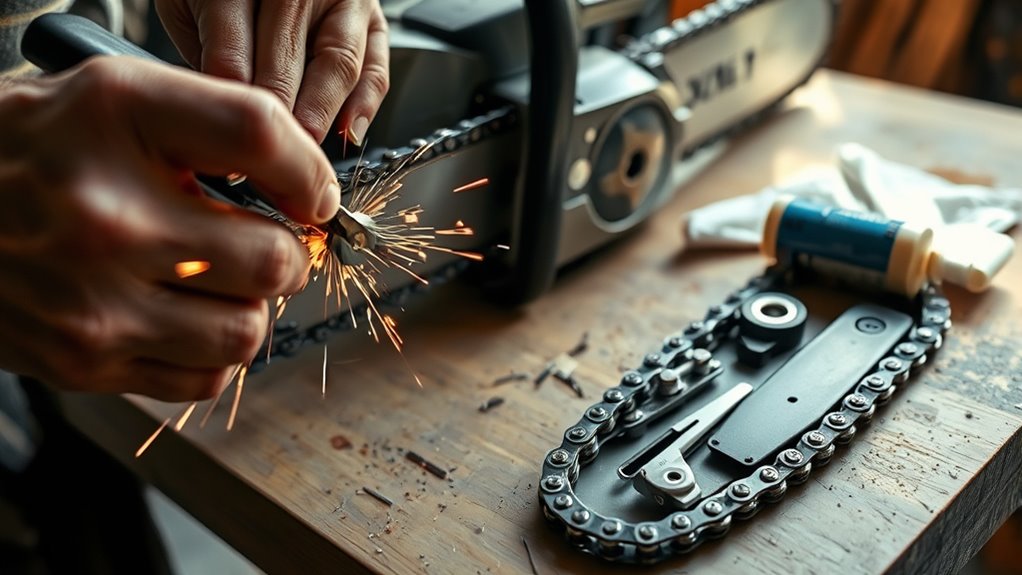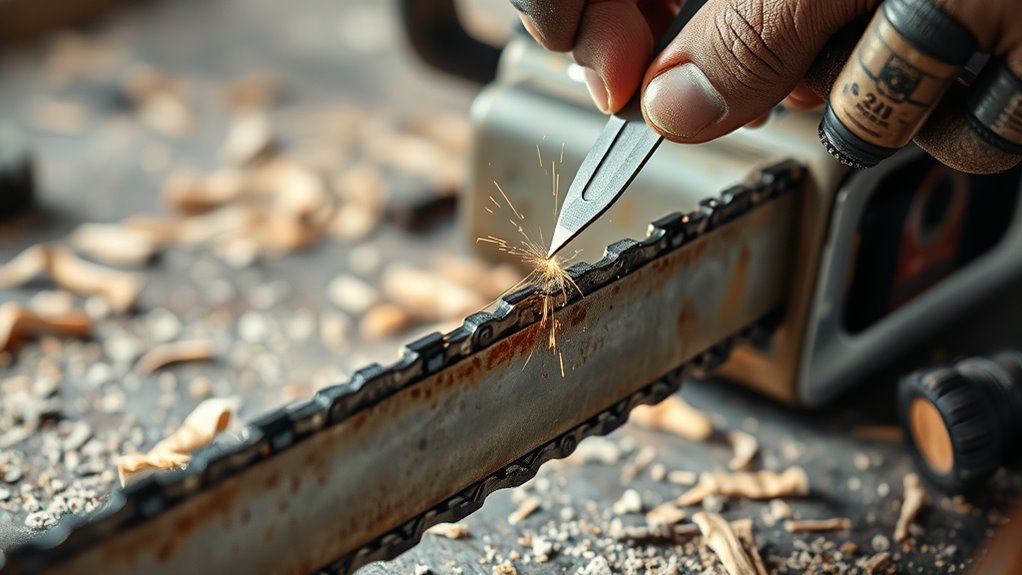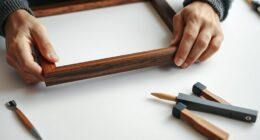To maintain your chainsaw, regularly sharpen the chain using a round file and keep the teeth at the correct angle, usually 30-35°, to guarantee smooth cuts. Clean debris, sawdust, and resin buildup from the chain, bar, and air filter with a brush or compressed air. Check the chain tension and lubrication before each use, and always wear safety gear. For detailed steps, you’ll discover more essential tips to keep your chainsaw in top shape.
Key Takeaways
- Regularly clean debris and resin buildup from the chain, bar, and air filter to ensure smooth operation.
- Use a proper file or sharpener to maintain the correct angle (30-35°) when sharpening the chain teeth.
- Check and adjust chain tension after cleaning to prevent slack or over-tightening during cuts.
- Ensure the chain is well-lubricated with the correct oil before each use for optimal cutting and reduced wear.
- Inspect sprockets and guide bar for damage or wear, replacing parts as needed to maintain safety and efficiency.

Ever wonder how to keep your chainsaw running smoothly and safely? The secret lies in regular maintenance, especially sharpening and cleaning your saw. When it comes to keeping your chainsaw in top shape, two key factors are chain lubrication and safety gear. Proper chain lubrication isn’t just about keeping the chain moving efficiently; it also helps prevent overheating and reduces wear on the bar and chain. Make sure to check the oil reservoir before each use and top it off with the right bar and chain oil. A well-lubricated chain cuts more smoothly, saves you effort, and prolongs the life of your equipment. Always wear your safety gear when maintaining your chainsaw. Gloves, eye protection, and hearing protection aren’t optional—they’re essential for keeping you safe from flying debris, sharp edges, and loud noise.
Regular chainsaw maintenance, including lubrication and safety gear, ensures smooth, safe, and efficient cutting.
When sharpening your chainsaw, focus on maintaining the proper angle and sharpness of the cutting teeth. Dull teeth make cutting more laborious and increase the risk of kickback. You can sharpen the chain manually with a round file and a guide, or use a specialized chainsaw sharpener for quicker results. Always follow the manufacturer’s guidelines for the correct angle—most chainsaws require a 30 to 35-degree angle. As you sharpen, inspect each tooth for damage or excessive wear. If a tooth is chipped or bent, it’s best to replace it rather than trying to sharpen it. Keeping your chain evenly sharpened ensures consistent cuts and reduces the strain on your saw’s motor. Regular maintenance also includes inspecting the chain tension to ensure optimal performance.
Cleaning your chainsaw is equally important. Remove debris, sawdust, and resin buildup from the chain, bar, and air filter. Use a small brush or compressed air to clear out dirt and grime, especially around the chain’s drive links and bar groove. Regular cleaning prevents buildup that can impede chain movement or cause the saw to overheat. Pay special attention to the sprocket and guide bar to ensure they turn freely. When cleaning, always wear your safety gear—gloves to protect your hands from sharp edges and eye protection to guard against flying debris. After cleaning, check the chain tension and adjust if necessary. A properly tensioned chain should fit snugly against the bar but still move freely when pulled by hand.
Consistently sharpening and cleaning your chainsaw not only improves performance but also keeps you safe during operation. When you combine this with diligent chain lubrication and wearing your safety gear, you ensure that each cut is efficient and safe. Regular maintenance might seem tedious, but it’s an investment in your safety and the longevity of your tool. When you treat your chainsaw with care, it will serve you well through many projects to come.
Frequently Asked Questions
How Often Should I Replace My Chainsaw Chain?
You should replace your chainsaw chain when it shows signs of significant wear, such as dullness even after sharpening or frequent chain slips. The chain replacement frequency depends on usage and the chain’s lifespan, but generally, you might need a new chain every 3-5 years with regular use. Keep an eye on the chain’s condition to guarantee safe and efficient cutting, and replace it promptly when it no longer performs well.
Can I Sharpen My Chainsaw Blade With Household Tools?
You can sharpen your chainsaw chain with household tools, but it’s not ideal. Household tools like files or grinders may work temporarily, but they lack precision for proper chain sharpening. For the best results, use a chainsaw chain sharpening kit designed for this purpose. This guarantees your chain stays sharp, cuts efficiently, and lasts longer. Relying on proper tools helps maintain your chainsaw’s performance and safety.
What Type of Oil Is Best for Chainsaw Maintenance?
Wondering what kind of oil is best for your chainsaw? Well, you don’t want to use just any oil, or you’ll end up with a dull chain faster than you can say “firewood.” Stick to high-quality chain oil selection, designed specifically for chainsaws, and remember to maintain proper oiling frequency. This keeps your chainsaw running smoothly, prevents overheating, and saves you from annoying breakdowns in the middle of a tough cut.
How Do I Prevent Rust on My Chainsaw?
To prevent rust on your chainsaw, you should keep it clean and dry after each use. Apply a light coat of oil to metal parts to protect against moisture, and always store it properly in a dry, covered area. Practice chainsaw safety by handling it carefully and avoiding exposure to rain or humidity. Proper storage and regular maintenance help keep your chainsaw rust-free and ready for any task.
Is It Necessary to Winterize My Chainsaw?
Winterizing your chainsaw is like prepping a boat for winter; it helps protect your tool from damage. You should definitely do seasonal maintenance and proper chainsaw storage to prevent rust and corrosion. Drain the fuel, clean it thoroughly, and store it in a dry, sheltered place. This keeps your chainsaw in top shape, ready to cut when spring comes around. Proper winterization extends its lifespan and guarantees safety during use.
Conclusion
Remember, a sharp and clean chainsaw is a safe and efficient one. Regular maintenance might seem like a hassle, but it pays off in the long run. Keep your chainsaw in top shape by sharpening the chain and cleaning it after every use. As the saying goes, “A stitch in time saves nine.” By taking a few moments now, you’ll guarantee your chainsaw performs perfectly whenever you need it. Stay diligent, and it’ll serve you well!









